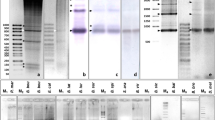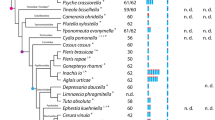Abstract
A chromosome-specific satellite DNA from the South American fish species Leporinus obtusidens has been isolated and characterized. Sequence analysis and Southern hybridization studies indicate that the cloned 483-bp fragment is 60% AT rich and appears to comprise two diverged monomers. A highly variable low-copy number polymorphism was detected and, thus, this satellite DNA may serve as a valuable genetic marker. Using a Southern blot approach, the cloned satellite DNA cross-hybridized strongly to the DNA of Leporinus elongatus but failed to detect homologous sequences in the genomes of other closely related Leporinus species and higher vertebrates. Using fluorescence in situ hybridization to mitotic metaphase spreads of L. obtusidens and L. elongatus, this satellite DNA was located to the (peri)centromeric region of one single chromosome pair in both species. As the cloned satellite DNA sequence clearly evolved along a chromosomal lineage and is highly variable, it may serve as a very useful marker in further genetic, molecular and cytogenetic studies of the genus Leporinus.
Similar content being viewed by others
References
Baltimore D (1981) Gene conversion: some implications for immunoglobulin genes. Cell 24: 592–594.
Blin N, Stafford DW (1976) A general method for isolation of high molecular weight DNA from eukaryotes. Nucleic Acids Res 3: 2303–2308.
Datta U, Dulla P, Mandal K (1988) Cloning and characterization of a highly repetitive fish nucleotide sequence. Gene 62: 331–336.
Denovan EM, Wright JM (1990) A satellite DNA family from pollock (Pollachius virens). Gene 87: 279–283.
Ekker M, Fritz A, Westerfield M (1992) Identification of two families of satellite-like repetitive DNA sequences from the zebrafish (Brachydanio rerio). Genomics 13: 1169–1173.
Elder FE, Turner BJ (1994) Concerted evolution at the population level: Pupfish Hind III satellite DNA sequences. Proc Natl Acad Sci USA 91: 994–998.
Franck JP, Wright JM (1993) Conservation of a satellite DNA sequence (SATB) in the tilapiine and haplochromine genome (Pisces: Cichlidae). Genome 36: 187–194.
Franck JP, Kornfield I, Wright JM (1994) The utility of SATA satellite DNA sequences for inferring phylogenetic relationships among three major genera of tilapiine cichlid fishes. Mol Phylogenet Evol 3: 10–16.
Gaff C, du Sart D, Kalitsis P, Iannello R, Nagy A, Choo KHA (1994) A novel nuclear protein binds centromeric alpha satellite DNA. Hum Mol Genet 3: 711–716.
Garrido-Ramos MA, Jamilena M, Lozano R, Ruiz-Rej\'on C, Ruiz-Rej\'on M (1994) Cloning and characterization of a fish centromeric satellite DNA. Cytogenet Cell Genet 65: 233–237.
Haaf T, Schmid M (1984) An early stage of ZW/ZZ sex chromosome differentiation in Poecilia sphenops var. melanistica (Poeciliidae, Cyprinodontiformes). Chromosoma 89: 37–41.
Haaf T, Schmid M (1991) Chromosome topology in mammalian interphase nuclei. Exp Cell Res 192: 325–332.
Haaf T, Warburton PE, Willard HF (1993) Integration of human \ga-satellite DNA into simian chromosomes: centromere protein binding and disruption of normal chromosome segregation. Cell 70: 681–696.
Haaf T, Schmid M, Steinlein C, Galetti Jr PM, Willard (1993) Organization and molecular cytogenetics of a satellite DNA family from Hoplias malabaricus (Pisces, Erythrinidae). Chrom Res 1: 77–86.
Haaf T, Mater AG, Wienberg J, Ward DC (1995) Presence and abundance of CENP-B box sequences in great ape subsets of primate-specific alpha-satellite DNA. J Mol Evol 41: 487–491.
Köhler MR, Vogt PH (1994) Interstitial deletions of repetitive DNA blocks in dicentric human Y chromosomes. Chromosoma 103: 324–330.
Koehler MR, Dehm D, Guttenbach M, Nanda I, Haaf T, Galetti P-M, Schmid M (1997) Cytogenetics of the genus Leporinus (Pisces, Anostomidae). I. Karyotype analysis, heterochromatin distribution, and sex chromosomes. Chrom Res 5: 1–11.
Larin Z, Fricker MD, Tyler-Smith C (1994) De novo formation of several features of a centromere following introduction of a Y alphoid YAC into mammalian cells. Hum Mol Genet 3: 689–695.
Matsumoto H, Masukata H, Muro Y, Nozaki N, Okazaki T (1989) A human centromere antigen (CENP-B) interacts with a short specific sequence in alphoid DNA, a human centromeric satellite. J Cell Biol 109: 1963–1973.
Miklos GLG (1985) Localized highly repetitive DNA sequences in vertebrate and invertebrate genomes. In: MacIntyre RJ, ed. Molecular Evolutionary Genetics. New York: Plenum Press, pp. 241–321.
Moyer SP, Ma DP, Thomas TL, Gold JR (1988) Characterization of a highly repeated satellite DNA from the cyprinid fish Notropis lutrenensis. Comp Biochem Physiol 91B: 639–646.
Ohta T, Dover G (1983) Population genetics of multigene families that are dispersed onto two or more chromosomes. Proc Natl Acad Sci USA 80: 4079–4083.
Pearson WR, Lipman DJ (1988) Improved tools for biological sequence comparison. Proc Natl Acad Sci USA 85: 2444–2448.
Schimke RT (1984) Gene amplification in cultured animal cells. Cell 37: 705–713.
Singer MF (1982) Highly repeated sequences in mammalian genomes. Int Rev Cytol 76: 67–112.
Smith GP (1976) Evolution of repeated DNA sequences by unequal crossing over. Science 191: 528–535.
Vogt P (1990) Potential genetic functions of tandem repeated DNA sequence blocks in the human genome are based on a highly conserved \lschromatin folding code\rs. Chromosoma 84: 301–336.
Vogt P (1992) Code domains in tandem repetitive DNA sequence structures. Chromosoma 101: 585–589.
Wichman HA, Payne CT, Ryder OA, Hamilton MJ, Maltbie M, Baker RJ (1991) Genomic distribution of heterochromatic sequences in equids: implications to rapid chromosomal evolution. J. Hered 82: 369–377.
Willard HF (1991) Evolution of alpha satellite. Curr Opin Genet Dev 1: 509–514.
Willard HF, Waye JS (1987) Hierarchical order in chromosome specific human alpha satellite DNA. Trends Genet 3: 192–198.
Wright JM (1989) Nucleotide sequence, genomic organization and evolution of a major repetitive DNA family in tilapia (Oreochromis mossambicus/hornorum). Nucleic Acids Res 17: 5071–5079.
Author information
Authors and Affiliations
Rights and permissions
About this article
Cite this article
Koehler, M.R., Haaf, T., Guttenbach, M. et al. Cytogenetics of the Genus Leporinus (Pisces, Anostomidae). II. Molecular Cytogenetics, Organization and Evolutionary Conservation of a Chromosome-Specific Satellite DNA from Leporinus obtusidens . Chromosome Res 5, 325–331 (1997). https://doi.org/10.1023/B:CHRO.0000038763.52875.48
Issue Date:
DOI: https://doi.org/10.1023/B:CHRO.0000038763.52875.48




